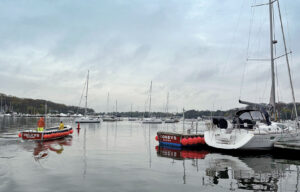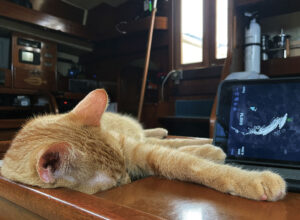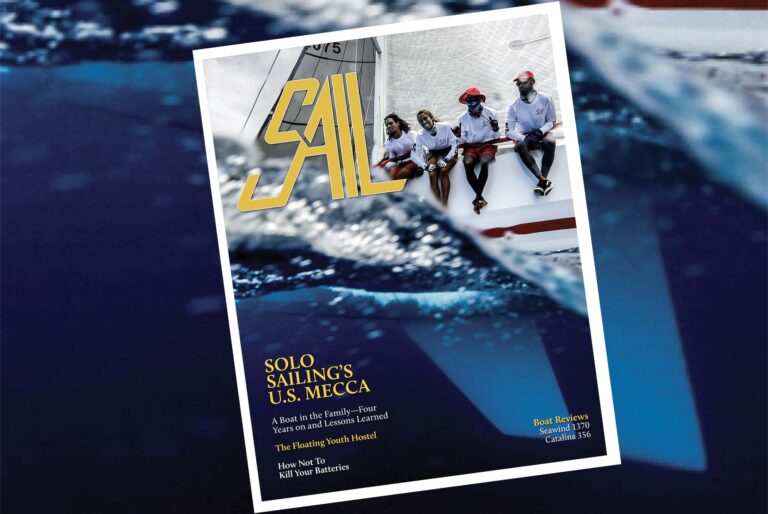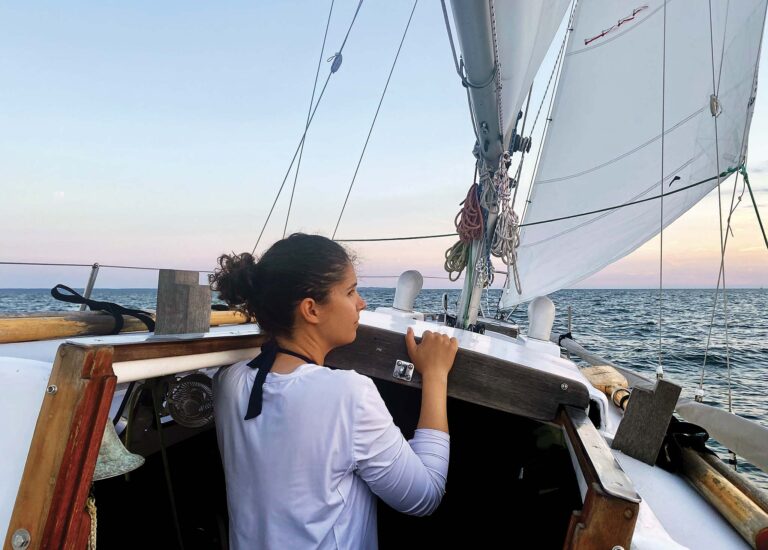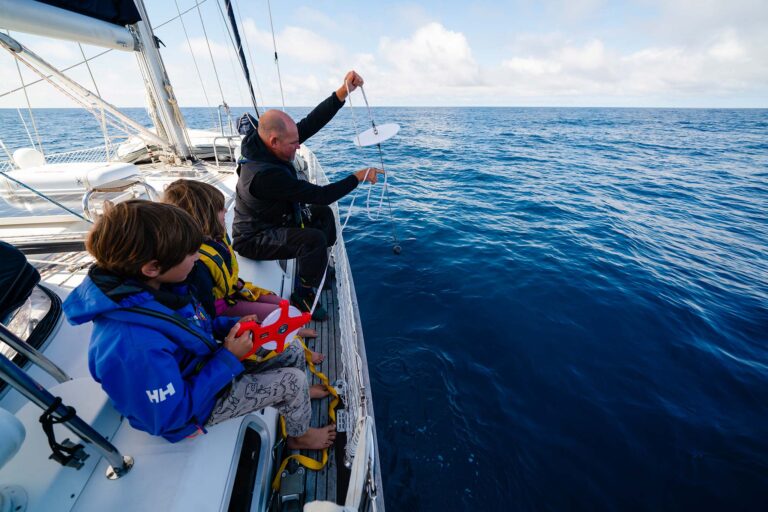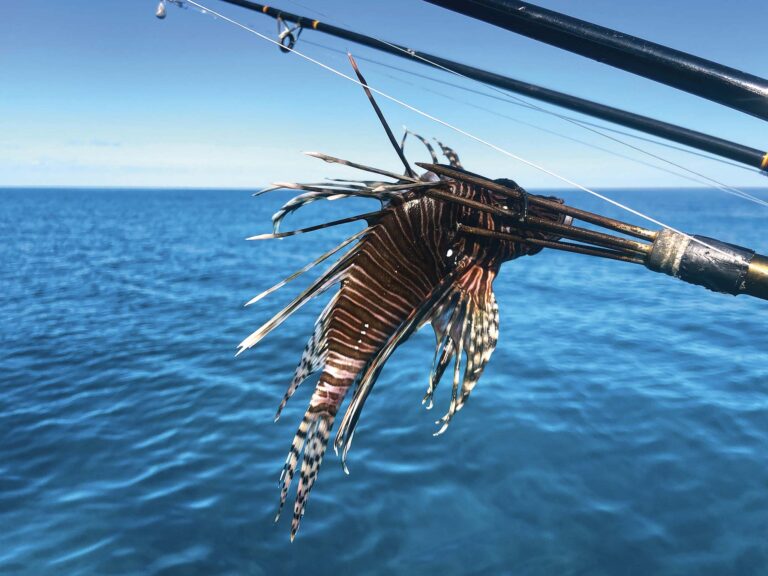While sailing alone one summer on the south shore of Lake Superior on my Westsail 32, Antares, I approached Michigan’s Keweenaw Peninsula from the east. The Keweenaw juts out into the lake like a giant thumb. Through its base runs the tranquil Portage River, a handy shortcut for boats traveling this coast.
After motoring up Keweenaw Bay, I anchored for the night in an open marshy area on a little channel just off the Portage. I woke next morning to a flat calm. I was so eager to reach the town of Houghton, where I planned to provision for a visit to Isle Royale, I didn’t even glance at the chart before leaving. I raised the anchor, gunned the engine and headed out the channel, cutting close to a little island off to port.
Suddenly, with a sickening lurch, the bow of the boat jumped high in the air as Antares slammed into a sandbank. I’d done more than just run aground—I’d run her up so high and dry I could almost have stepped off the boat to paint her bottom.
I tried to back off, but the thrashing prop only stirred up a dirty blob of mud and sand. Antares is a big girl—she weighs over 22,000 pounds—and with her long full keel she is not easy to dislodge once she gets stuck.
Next I tried to kedge off. I dug out my spare 35-pound CQR anchor with its 35-foot chain leader and 150 feet of rope rode, then rowed out and dropped it in the channel. Back aboard I put the rode on a winch and started cranking, but the anchor only dragged through the muddy bottom. Antares remained stubbornly aground.
A fisherman in a nearby bass boat, enjoying this unexpected entertainment, came over to help. He first tried to pull Antares free with his 8hp trolling motor. I knew this wouldn’t work, but didn’t want to discourage him. Next I persuaded him to try his big motor, but its 150 horses also failed to budge Antares. The fisherman muttered something about a meeting and with a roar from his big engine vanished down the river in a puff of smoke.
Good cruisers pride themselves on being self-sufficient, so I was determined to free myself if at all possible. I thought of the famous cruising sailor Hal Roth, who once went aground off Australia. If Hal Roth could get off a coral reef in Torres Strait, I figured I could get myself off a sandbank in the Portage River.
On the marshy shore, all the way across the channel, stood a lone tree. By good fortune it was located exactly off my starboard beam. “That’s my ticket out of here,” I thought, reasoning that if I could run a line from the masthead to the tree, I should be able to careen Antares over on her side. With the reduced draft, I just might pull her free from the sandbar.
I tied together 550 feet of anchor rode, spare halyards and dock lines, rowed across the channel, and tied one end to the tree. Back aboard Antares, I climbed the mast to a point about eight feet below the masthead and tied on a big block with a stout piece of line. I then ran the line from the tree through the block on the mast and down to a primary winch in the cockpit via the starboard genoa block. As a precaution, I also set up the running backstay on the port side to counter the pull from the tree.
After three hours of grinding the winch, I was drenched in sweat and my back and arms were aching. From her initial position heeling hard to port, I had slowly righted Antares and now had her listing sharply to starboard. She was leaning toward open water, but was still hard aground. The long line from the mast to the tree was now bar taut, stretching only a few feet above the surface—a serious hazard to any passing jet-skiers. Fortunately my side channel was little used and traffic on the river was light.
Eventually, a kindly, broad-shouldered fisherman stopped alongside and offered to help. “If you could give me a hand cranking, that would be great,” I said. He came aboard and cranked away until I thought he was going to tear the winch out of the boat. Veins bulged on his neck, and the genoa block cried in pain. I wasn’t sure which would explode first, his heart or the block. “That’s all I got,” he gasped and collapsed against the cabin.
After he recovered the fisherman climbed back in his boat and buzzed Antares a few times, hoping his wake would break her free, but she just dug in her heels. I waved thanks and began grinding the winch handle with my foot, pulling in a few inches of line with each quarter turn.
Swatting black flies under the hot midday sun, I was now running out of steam. I’d been at it for six hours. Antares was heeled so far over that her caprail was nearly in the water, but still she clung to the bottom like a barnacle. In the heat of battle I had banged my shin, and streaks of blood now stained the deck. A tangle of lines and anchor chain mixed with mud and lake weed lay strewn across the cockpit. I took a few minutes to eat and drink a little, then pressed on. Sweat ran off me like a river, but I wouldn’t give up the fight.
Finally a fresh breeze piped up and started blowing over the port quarter. I rigged a temporary sheet block and set the genoa. This helped heel Antares just a little closer toward freedom. Slowly her bow turned toward deep water.
Thinking ahead, I flaked out the genoa sheet and untied the stopper knot at the end so it could run free. Going forward I also readied the anchor to drop in an instant. If I didn’t stop the boat fast once she came off the shoal, she’d blow ashore on the other side of the channel. I’d have only a minute to drop the genoa and set the anchor. Using the engine was out of the question—the prop could easily catch the line from the masthead as it went slack, or it might catch the genoa sheet if it flipped overboard.
I kept cranking on the winch. The line running from the masthead to the tree was now stretched tighter than ever. But the groaning genoa block still held. As I worked the handle I kept warily off to one side, afraid it might explode any moment like a hand grenade.
The wind kept increasing. Little white caps started dancing across the water. The genoa pulled like a tow horse, and I began to feel the boat moving under my feet. Antares inched sideways through the sand. Sounding with a lead line, I found there was four feet of water aft and six feet forward. She was now just clinging by her tail to the bottom.
Finally, seven hours after going aground, Antares tore free with a mighty heave and swept into deep water. I let the genoa sheet fly and dashed forward, where I doused the sail with one hand and let go the anchor with the other, paying out chain as fast as I could.
In a flash Antares was halfway across the channel, the opposite shore fast approaching. “Please set!” I thought, snubbing the chain down in the windlass. The chain tightened and Antares swung her head smartly into the wind. I was floating free. I’d done it!
I was exhausted, covered in mud, blood and sweat, but we had escaped. It took another hour to row ashore, untie my line from the tree, bring everything aboard, and clean up the mess. But I didn’t mind. I was overjoyed to be free, and when all was clear I motored the rest of the way up to Houghton, carefully checking the chart every step of the way.
I never felt so fine. That night in town, the beer never tasted so good.




